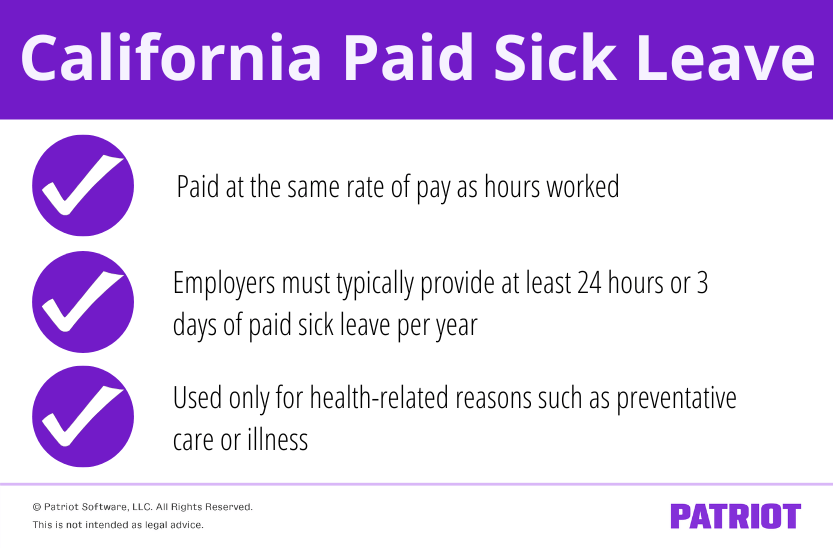Some states, like California, require mandatory paid sick leave. The majority of California’s employers must offer paid sick leave to their employees. So, what is the California sick leave law?
What is the California paid sick leave law?
Paid sick leave is paid time off given to employees for health-related reasons. Through paid sick leave, an employer pays the employee for time off of work to recover from an illness, injury, or disability. Although many states do not require paid sick leave, California has a mandatory paid sick leave law.
California’s Healthy Workplaces, Healthy Families Act of 2014 (HWHFA) requires most California employers to provide paid sick leave to their employees. California employers who must provide paid sick leave must follow rules set by the state. As an employer, you are responsible for providing eligible employees with paid sick leave and keeping records of it.
California paid sick leave may be separate from any other paid time off (PTO) you offer and is not a part of the Family and Medical Leave Act (FMLA).
What does California’s paid sick leave cover?
Employees can use paid sick time for themselves or a family member for:
- Preventative care or diagnosis of an illness (employee or family member)
- Care or treatment for an existing health condition (employee or family member)
- Recovery from domestic violence, sexual assault, or stalking (employee)
Under California’s paid sick leave law, family members include parents, children, spouses, registered domestic partners, grandparents, grandchildren, and siblings.
California paid sick leave does not cover leave for travel, relocation, or personal time that is not health-related.
Who must offer paid sick leave: California?
Again, the majority of employers in California must offer paid sick leave. However, the following employers do not have to offer it:
- Employers who have a collective bargaining agreement
- Providers of in-home supportive services
- Certain air carrier companies
Which employees are covered?
You must provide paid sick leave to all employees, including:
Both exempt and nonexempt employees are eligible for paid sick leave.
Employees working for a government entity who are retired and receive annuities are not covered under California paid sick leave.
Coverage and accrual rules
To be eligible for California paid sick leave, employees must work at least 30 days for the same employer in a 12-month period. Employees can begin taking paid sick leave after working for an employer for 90 days. The accrual begins on the employee’s hire date.
Employers can limit the amount of paid sick leave an employee can use in one year to 24 hours or three days.
If you rehire an employee within one year, the employee must receive any accrued paid sick leave they had before leaving. If you paid the employee for their accrued paid sick leave at the end of their employment, the employee is subject to the paid sick leave law upon their rehire date.

Providing sick pay: California
The Healthy Workplaces, Healthy Families Act has specific requirements for how much employers must pay employees for paid sick leave. Employers must pay nonexempt employees taking paid sick leave at the same rate of pay as if they were working. There are two options for paying nonexempt employees sick leave:
- Use the regular, non-overtime rate for the nonexempt employee. Calculate this rate by dividing the total non-overtime wages by the total of non-overtime hours worked.
- Determine the total compensation over a 90-day period, excluding any overtime pay. Divide the total compensation by the number of non-overtime hours worked.
Your exempt employees must be paid the same way you pay other types of paid leave, such as vacation or PTO. You cannot reduce an employee’s rate of pay if they use California paid sick leave.
Employer obligations
The California paid sick leave law requires that employers do all of the following:
- Provide a written notice of paid sick leave availability upon hiring new employees
- Display available sick leave balances on employee’s pay stubs or provide separate documentation along with an employee’s paycheck
- Give the Notice to Employee to all employees
- Post the paid sick leave poster where employees can easily see and read it
- Keep records of all paid sick leave paid to employees and the amount of time each employee uses for at least three years. Track this time separately from other types of leave you offer to employees
Also, employers may not discipline employees who use their accrued paid sick leave.
Calculating California paid sick leave
California gives employers two options for calculating paid sick leave for employees:
Both of these options apply to the state law and may differ based on the local laws for your business.
Accrual
With accrual, employees earn one hour of paid sick leave for every 30 hours worked. Generally, you must provide at least 24 hours or three days of paid sick leave to your employees per year.
Other accrual methods are acceptable as long as they comply with the law. Employees must accrue paid sick leave on a regular basis (e.g., monthly).
Lump sum
Lump sum sick leave is given to employees all at once for them to use as soon as they qualify. This is also known as front-loading.
With the lump sum method, provide your eligible employees with 24 hours or three days of paid sick leave at the beginning of the period (e.g., January 1). Do not use the accrual method if you provide paid sick leave in a lump sum at the beginning of the period.
What happens to unused accrued sick leave?
So, what happens if your employee doesn’t use their sick leave by the end of the period? Well, you are required to allow employees to carry over unused accrued sick leave year to year. However, if an employee carries over time, employers can limit their total accrued paid sick leave to 48 hours.
For example, your employee has 72 hours of accrued paid sick leave and wants to carry over their hours to next year. By law, you can set a limit of 48 hours (or six days) of paid sick leave and that is the maximum amount your employee can carry over to the next year.
Grandfathered policies
If you have a sick leave policy prior to January 1, 2015 that has not changed, you may continue to use the policy if:
- Employees accrue at least one day or eight hours of paid sick leave or paid time off within three months of employment each year
- Your employees earn at least three days or 24 hours of paid sick leave or paid time off within nine months of the start of their employment
If your policy has changed since January 1, 2015 or does not meet the above requirements, you must follow the California paid sick leave law.
City ordinances that differ from state law
Certain cities in California have laws that differ from the California sick leave law. You must comply with both state and local laws when offering sick leave to your employees. Some localities with their own paid sick leave laws include:
- Berkeley
- Emeryville
- Los Angeles
- Long Beach
- Oakland
- San Diego
- San Francisco
- Santa Monica
Localities may have different obligations for employers depending on the size of their business. For example, San Francisco requires that small businesses provide 40 hours of paid sick leave to employees, and all other businesses must offer 80 hours.
Paid sick leave vs. SDI
California paid sick leave under the Healthy Workplaces, Healthy Families Act is different from the leave available through the California State Disability Insurance, or SDI, program. Employees fund the SDI program by paying into a state tax each paycheck. Employers provide and pay California paid sick leave.
SDI is available for employees needing short-term disability or paid family leave (PFL). Employees must apply for SDI benefits through the state.
Employees may use SDI if they are unable to work due to non-work-related injury, pregnancy, or childbirth. They may use PFL to care for seriously ill family members or bond with a new child. Employees can also use SDI for reasons related to a family member’s military deployment.
Tracking time off, like paid sick leave, should be a breeze. Patriot’s payroll software lets you set up time-off accruals to simply calculate paid sick leave for your employees. And, our online time and attendance add-on allows you to easily track time off for employees. Try it for free today!
This article has been updated from its original publication date of July 7, 2015.
This is not intended as legal advice; for more information, please click here.


